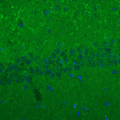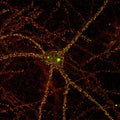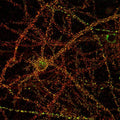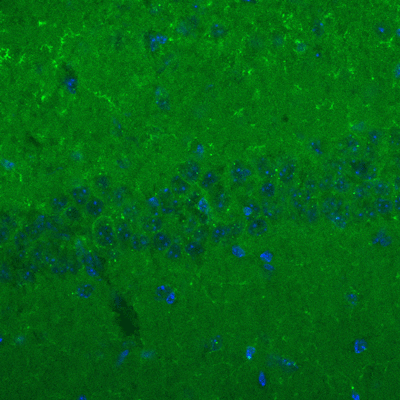Ships: 1-2 business days
Product Specific References for Applications and Species
- Immunocytochemistry: Rat
- Immuno-Gold Electron Microscopy: Rat
- Immunohistochemistry: Mouse
- Western Blot: Human | Mouse | Rat
| Immunocytochemistry: Rat | ||
| PMID | Dilution | Publication |
| 30143647 | 1:500 | Lee SH, et al. 2018. Reciprocal control of excitatory synapse numbers by Wnt and Wnt inhibitor PRR7 secreted on exosomes. Nature Communications, 3434. |
| 25555912 | not listed | Wei Z, et al. 2013. Subunit-specific regulation of N-methyl-D-aspartate (NMDA) receptor trafficking by SAP102 protein splice variants.. The Journal of Biological Chemistry, 5105-5116. |
| 23143515 | 1:250 | Shin SM, et al. 2012. GKAP orchestrates activity-dependent postsynaptic protein remodeling and homeostatic scaling.. Nature Neuroscience, 1655-1666. |
| 22593065 | 1:250 | Danielson E, et al. 2012. S-SCAM/MAGI-2 is an essential synaptic scaffolding molecule for the GluA2-containing maintenance pool of AMPA receptors. Journal of Neuroscience, 6967-6980. |
| Immno-Gold Electron Microscopy: Rat | ||
| PMID | Dilution | Publication |
| 29134655 | 1:20 | Suzuki T, et al. 2018. Protein components of post-synaptic density lattice, a backbone structure for type I excitatory synapses. Journal of Neurochemistry, 390-407. |
| Immunohistochemistry: Mouse | ||
| PMID | Dilution | Publication |
| 35121636 | 1:20 | Matsuura K., et al. 2022. SIPA1L1/SPAR1 interacts with the neurabin family of proteins and is involved in GPCR signaling. The Journal of Neuroscience, 2448-2473. |
| 25637745 | not listed | Braude JP, et al. 2015. Deletion of Shank1 has minimal effects on the molecular composition and function of glutamatergic afferent postsynapses in the mouse inner ear.. Hearing Research, 52-64. |
| 20573181 | 1:1000 | Pham E, et al. 2010. Progressive accumulation of amyloid-beta oligomers in Alzheimer's disease and in amyloid precursor protein transgenic mice is accompanied by selective alterations in synaptic scaffold proteins. FEBS Journal, 3051-3067. |
| Western Blot: Human | ||
| PMID | Dilution | Publication |
| 28228252 | not listed | Xu J, et al. 2017. Complete Disruption of the Kainate Receptor Gene Family Results in Corticostriatal Dysfunction in Mice.. Cell Report, 1848-1857. |
| Western Blot: Mouse | ||
| PMID | Dilution | Publication |
| 38484863 | 1:1000 | Kelly-Castro, et al. 2024. MARK1 regulates dendritic spine morphogenesis and cognitive functions in vivo. Experimental Neurology, 114752. |
| 35662394 | 1:1000 | Dhume SH, et al. 2022. Distinct but overlapping roles of LRRTM1 and LRRTM2 in developing and mature hippocampal circuits. Elife, e64742. |
| 35121636 | 1:10 | Matsuura K., et al. 2022. SIPA1L1/SPAR1 interacts with the neurabin family of proteins and is involved in GPCR signaling. The Journal of Neuroscience, 2448-2473. |
| 28228252 | not listed | Xu J, et al. 2017. Complete Disruption of the Kainate Receptor Gene Family Results in Corticostriatal Dysfunction in Mice.. Cell Report, 1848-1857. |
| 27161151 | not listed | Wang X, et al. 2016. Altered mGluR5-Homer scaffolds and corticostriatal connectivity in a Shank3 complete knockout model of autism.. Nature Communications, 11459. |
| 25653350 | not listed | Zhang N, et al. 2015. S-SCAM, a rare copy number variation gene, induces schizophrenia-related endophenotypes in transgenic mouse model.. Journal of Neuroscience, 1892-1904. |
| 24153177 | not listed | Han K, et al. 2013. SHANK3 overexpression causes manic-like behaviour with unique pharmacogenetic properties.. Nature, 72-77. |
| 20573181 | 1:1000 | Pham E, et al. 2010. Progressive accumulation of amyloid-beta oligomers in Alzheimer's disease and in amyloid precursor protein transgenic mice is accompanied by selective alterations in synaptic scaffold proteins. FEBS Journal, 3051-3067. |
| Western Blot: Rat | ||
| PMID | Dilution | Publication |
| 30143647 | 1:1000 | Lee SH, et al. 2018. Reciprocal control of excitatory synapse numbers by Wnt and Wnt inhibitor PRR7 secreted on exosomes. Nature Communications, 3434. |






![Immunoblots on membranes prepared from whole mouse (MBM) and rat (RBM) brain, and from human hippocampus [HBM(H)], cerebral cortex [HBM(Cx)], and cerebellum [HBM(Cb)].](http://www.antibodiesinc.com/cdn/shop/products/validation-image-73-156-n127-31-wb3_120x120.jpg?v=1715619250)


